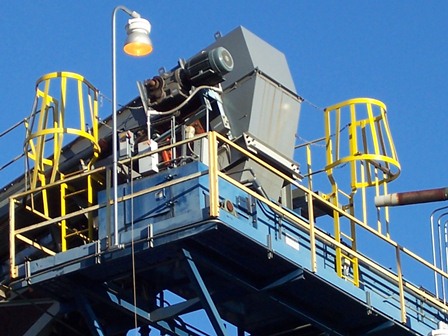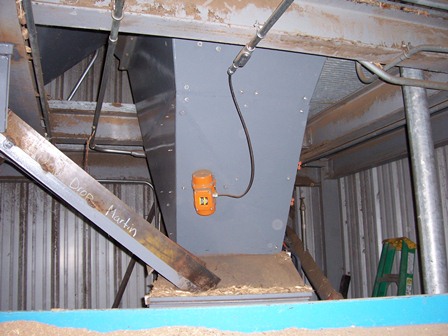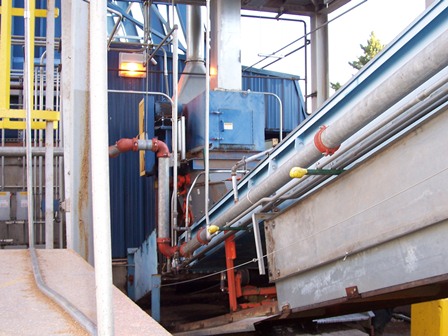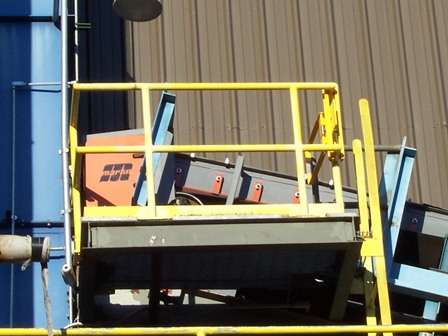Published: August 2nd 2016

A Minnesota power generating facility has completed the first phase of a program to drastically reduce dust and spillage from its biomass fuel handling system, helping to prevent fugitive material from reaching nearby homes and businesses. The complex project at Hibbing Public Utilities (HPU) included belt cleaners, new transfer points and modified chutes, settling zones and apron skirts, as well as vibration technology to improve material flow at key points. Company officials have been so satisfied with the upgrades from Martin Engineering that they are considering additional system enhancements to several other conveyors.
Hibbing Public Utilities has been providing electricity to the city of Hibbing and surrounding area for more than 100 years, and currently owns and operates a cogenerating plant that brings both steam heat and electricity to its service area. In partnership with Virginia Public Utilities, HPU formed a joint company called Laurentian Energy to deliver power from the abundant biomass resources nearby. Under a 20-year contract with Xcel Energy, the firm currently produces about 300,000 MW hours of electricity per year, approximately 70% of it from biomass. The fuel includes wood from open loop sources (such as waste wood, limbs and agricultural waste) and closed loop sources (dedicated crops of trees), with a goal of averaging 75% of the power generated from biomass fuels over the life of the agreement.
The material handling system at the Hibbing site is critical to the plant’s efficiency, but from the time it began operations in 2007, controlling dust and spillage was a challenge. “When construction of the biomass operation was completed, we had three air-supported conveyors and one bucket-type conveyor feeding the material,” explained Assistant General Manager and Director of Power Production Gary Myers. “The boiler can produce up to 135,000 pounds of steam per hour, used to turn three turbo-generators with a combined capacity of 35 MW.”

Because of the largely residential area in which the facility is located, controlling carryback and spillage were among the first priorities. After a thorough evaluation of the material handling system, Martin Engineering technicians began by installing primary and secondary belt cleaners on all four conveyors. The primary units on each belt are Martin® Brush Cleaners, a unique electric-powered model that provides an effective, cost-efficient solution for residual belt-borne material. The secondary units are Martin® SAF2™ Belt Cleaners, a versatile “deflected blade” design that features a gentle pressure to prolong service life and prevent belt damage.
“We installed electric brush cleaners on each conveyor, because they’re very effective on the type of cleated belts used at this facility,” observed Martin Engineering Territory Manager Tom Hines. “The rotating brush delivers good cleaning performance in difficult applications, including belts with ribs, grooves or chevrons and belts carrying sticky materials or stringy fibers.”
“Part of the problem occurred on the three air-supported conveyors,” Myers recalled. “Some of the sections were at steep angles, and with the variable size and moisture content of the fuel, there were always chips that would fall back down.”
To address the issue, Martin Engineering technicians removed troublesome sections of the air-supported conveyor and replaced them with specially-engineered transfer points. They also modified existing transfer points, installing drop chutes to help eliminate dust and transfer chutes with a hood-and-spoon design to improve the material flow.

“Reducing the material turbulence during transfers is key to preventing fugitive dust,” Hines observed. “By managing the material speed and direction, transfer chutes help minimize impact and wear on liners and belts, while containing the dust and spillage that are often generated at transfer points,” he said. “All of the chutes were field-fabricated, which helped us get an exact fit and minimize lead time.”
The transfer chutes employ special geometries that capture and concentrate the material stream as it travels through. Each unit is customized to suit the specific material characteristics and conveyor systems of the individual customer. They provide the dual benefits of minimizing aeration and preventing buildup within the chute, particularly important when dealing with combustible materials.
The installation team also placed electric rotary vibrators in key locations inside drop chutes to reduce the potential for plugging. To further ensure control of fugitive material, settling zones were created at the transfer points to slow the air speed, with dust curtains to contain airborne particles.

Finally, skirtboard sealing systems were installed on the sides of the loading zones to contain dust, eliminate spillage and reduce cleanup. Martin® ApronSeal™ Skirting was the first dual-sealing system on the market, as it incorporates a primary seal clamped on the steel skirtboard to keep lumps on the belt and a secondary or “outrigger” strip to capture any fines or dust particles that pass beneath the primary seal. The secondary seal lies gently on the belt and self-adjusts to maintain consistent strip-to-belt pressure, despite high-speed material movement and fluctuations in the belt’s line of travel.
Martin Engineering’s ApronSeal™ Skirting provides two wear surfaces on a single elastomer sealing strip, installed along the bottom of the skirtboard. When the bottom side of the strip against the belt is worn, the sealing strip is inverted, providing a second service life.
With the modifications in place, HPU reports significant reductions in spillage and airborne dust. “We’re very pleased with the results we’ve seen in fugitive material control,” Myers concluded. “We’re now reviewing several other conveyor sections to determine the opportunities for additional dust control measures. Our goal has always been to provide the Hibbing area with safe, reliable power that’s produced and delivered in an environmentally-responsible manner, and this work is a reflection of that commitment.”